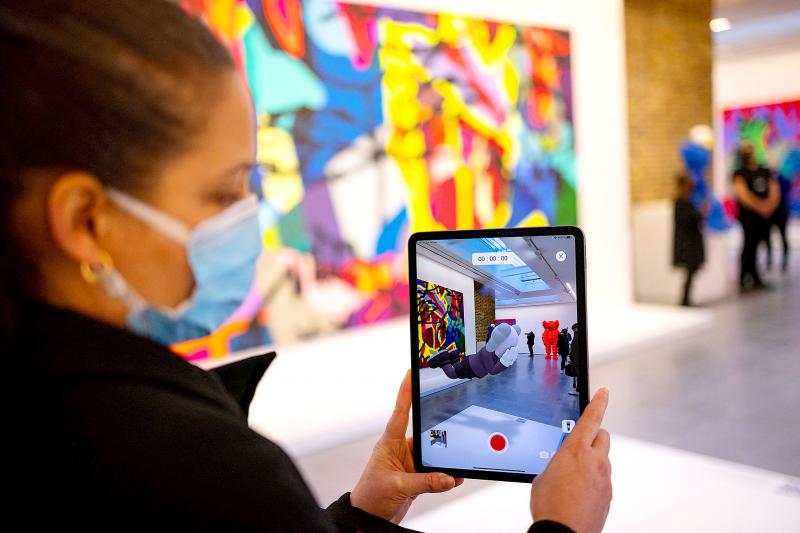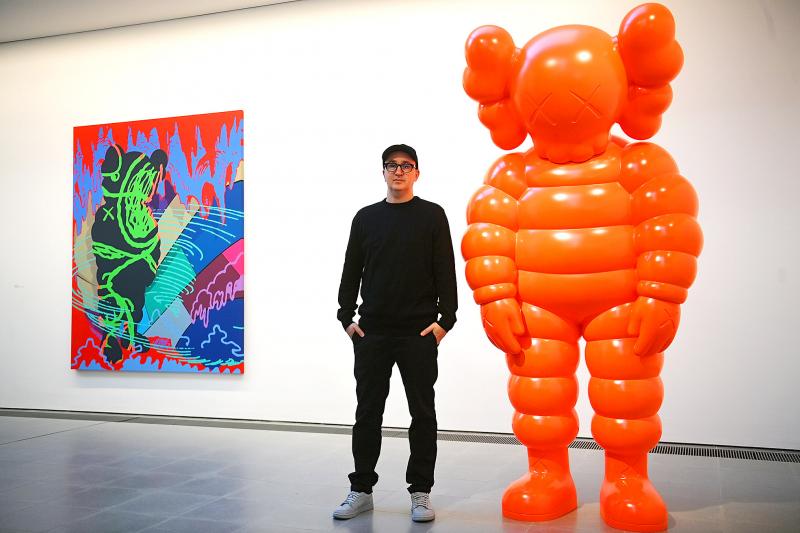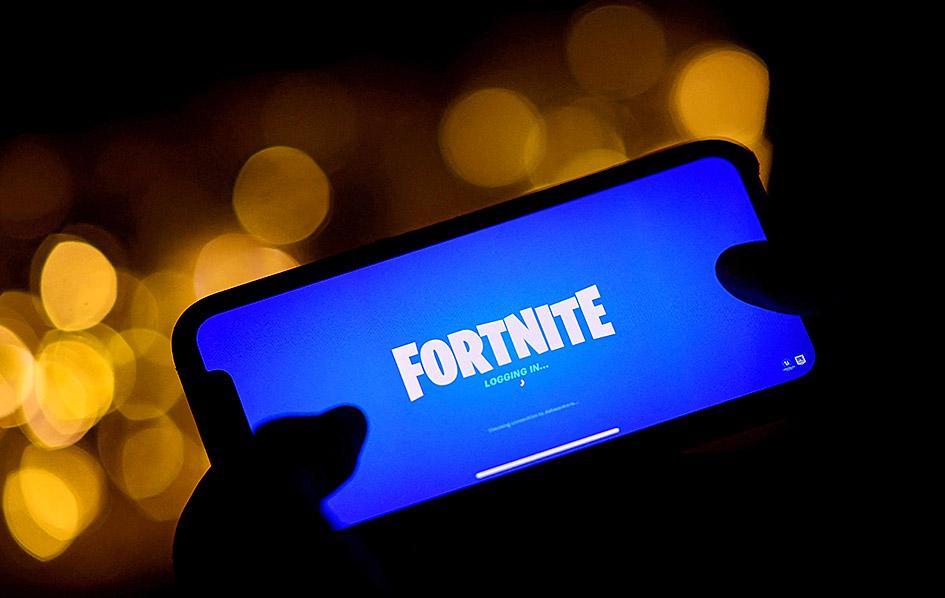On a frosty morning in London’s Hyde Park, onlookers aim their mobile phones at the top of the Serpentine Gallery.
The large sculpture of a blue man sitting on the roof is invisible to the naked eye but it is there — in augmented reality.
The sculpture is part of an installation by the American artist Kaws at the gallery, reproduced for the hundreds of millions of users of the video game Fortnite for the first time. Artistic director Hans Ulrich Obrist said the New Yorker’s exhibition — “New Fiction,” which opened Tuesday and ends on Feb. 27 — has three “layers.”

Photo : AFP
“It’s the Serpentine Gallery on Fortnite, it’s a Serpentine Gallery as a physical gallery with the exhibition of paintings and sculpture, and then as a third element, it’s the augmented reality AR component, which can be activated with a QR code,” he said.
For one week, the 400 million followers of Epic Games’ phenomenon can access a fully accurate replica of the museum in the game, walk around with their avatar, and view the works.
Epic Games has worked with internationally renowned singers in a similar way to perform in-game concerts.

Photo: EPA-EFE
“This is the first time Fornite has collaborated with the visual arts, with a public gallery,” Obrist said.
Seeing an exhibition in a game and physically is “very different,” he added, but the experiences were “complementary.” And he is hoping it may spark a mutual interest in both galleries and video games by all who attend in person or online.
CROSSING AUDIENCES

Photo: AFP
“For us, it’s about crossing audiences,” said Obrist. “We think it’s also interesting, the idea of a transgenerational dialogue, because, of course, the average age of the players of the game is definitely much younger ... than the average visitor to a museum, to an exhibition.
“So we hope also that a whole new generation will come to the gallery and for us, it has always been this idea of art for all.”
Daniel Birnbaum, artistic director of Acute Art, whose app can also be used to see the exhibition, said the project with Fortnite will reach more people than anything he has ever curated, including the Venice Biennale.
“In fact, it will today reach an audience that is probably 10 times bigger than the Venice Biennale,” he said. He called the show “the beginning of a new kind of project,” combining the local with the global.
“There has been a lot of talk lately about the metaverse or the multiverse ... This is not about that metaverse. It is the metaverse. It happens in many places at the same time.”
For Kaws too, the incentive was to make his work more accessible.
“I’m more interested in knowing that the work that I created can be experienced in the same form by a kid in India or a kid in London ... it is fascinating for me,” said the 47-year-old painter and sculptor.
The former graffiti artist, whose real name is Brian Donnelly, said: “Such a large community is suddenly going to be able to walk into an exhibition in the museum, seeing paintings and sculptures.
“But I think, for kids, it’s going to be the first time it creates a comfort zone to experience an exhibition.”
NO SHOOTING
Kaws’ pop art-style characters, famous around the world as giant installations and as merchandise, will appeal to Fortnite’s young audience with their colorful, cartoon-like appearance. The artist said his works will be displayed in the “Creative Hub” — a specific mode away from those where players fight to be the last survivor.
“There won’t be any shootouts,” he joked.
As for whether adrenaline-fuelled gamers will actually stop to contemplate his works in the game, he conceded: “It’s hard to say.
“If you take an 11-year-old to a traditional museum, you don’t know if they’re going to look at the works. It’s no different.”

June 23 to June 29 After capturing the walled city of Hsinchu on June 22, 1895, the Japanese hoped to quickly push south and seize control of Taiwan’s entire west coast — but their advance was stalled for more than a month. Not only did local Hakka fighters continue to cause them headaches, resistance forces even attempted to retake the city three times. “We had planned to occupy Anping (Tainan) and Takao (Kaohsiung) as soon as possible, but ever since we took Hsinchu, nearby bandits proclaiming to be ‘righteous people’ (義民) have been destroying train tracks and electrical cables, and gathering in villages

Dr. Y. Tony Yang, Associate Dean of Health Policy and Population Science at George Washington University, argued last week in a piece for the Taipei Times about former president Ma Ying-jeou (馬英九) leading a student delegation to the People’s Republic of China (PRC) that, “The real question is not whether Ma’s visit helps or hurts Taiwan — it is why Taiwan lacks a sophisticated, multi-track approach to one of the most complex geopolitical relationships in the world” (“Ma’s Visit, DPP’s Blind Spot,” June 18, page 8). Yang contends that the Democratic Progressive Party (DPP) has a blind spot: “By treating any

Swooping low over the banks of a Nile River tributary, an aid flight run by retired American military officers released a stream of food-stuffed sacks over a town emptied by fighting in South Sudan, a country wracked by conflict. Last week’s air drop was the latest in a controversial development — private contracting firms led by former US intelligence officers and military veterans delivering aid to some of the world’s deadliest conflict zones, in operations organized with governments that are combatants in the conflicts. The moves are roiling the global aid community, which warns of a more militarized, politicized and profit-seeking trend

This year will go down in the history books. Taiwan faces enormous turmoil and uncertainty in the coming months. Which political parties are in a good position to handle big changes? All of the main parties are beset with challenges. Taking stock, this column examined the Taiwan People’s Party (TPP) (“Huang Kuo-chang’s choking the life out of the TPP,” May 28, page 12), the Democratic Progressive Party (DPP) (“Challenges amid choppy waters for the DPP,” June 14, page 12) and the Chinese Nationalist Party (KMT) (“KMT struggles to seize opportunities as ‘interesting times’ loom,” June 20, page 11). Times like these can